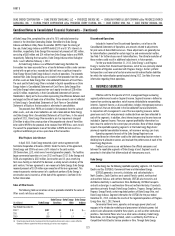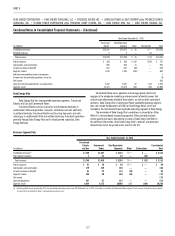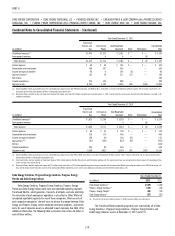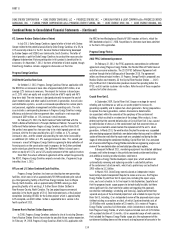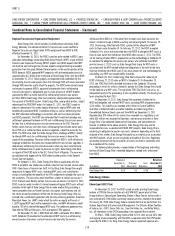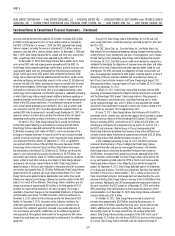Duke Energy 2012 Annual Report Download - page 152
Download and view the complete annual report
Please find page 152 of the 2012 Duke Energy annual report below. You can navigate through the pages in the report by either clicking on the pages listed below, or by using the keyword search tool below to find specific information within the annual report.
132
PART II
Combined Notes to Consolidated Financial Statements – (Continued)
DUKE ENERGY CORPORATION • DUKE ENERGY CAROLINAS, LLC • PROGRESS ENERGY, INC. • CAROLINA POWER & LIGHT COMPANY d/b/a PROGRESS ENERGY
CAROLINAS, INC. • FLORIDA POWER CORPORATION d/b/a PROGRESS ENERY FLORIDA, INC. • DUKE ENERGY OHIO, INC. • DUKE ENERGY INDIANA, INC.
recovery period is through 2026. For Progress Energy Carolinas, the recovery
period is over the previously estimated lives of the units.
Debt fair value adjustment. These costs represent purchase accounting
adjustments as a result of the merger with Progress Energy in July 2012 to
restate the carrying value of existing debt to fair value. The increase in the
carrying value of the debt is due to a general reduction in interest rates since
the underlying debt was issued. Since the debt is refl ected in capital structure
for rate setting purposes at its original carrying value and interest rate, the
increase in the carrying value of the debt is recorded to a regulatory asset.
Asset retirement obligations. These costs represent future removal
costs associated with the Duke Energy Registrants’ existing asset retirement
obligations. The Duke Energy Registrants do not earn a return on these balances.
The recovery period trends with the expiration of the COL for each nuclear
unit, the latest of which is 2043. See Note 9, Asset Retirement Obligations, for
additional information.
Net regulatory asset related to income taxes. These costs represent
the difference between the regulatory accounting of income taxes and the GAAP
accounting of income taxes. Regulatory assets and liabilities associated with
deferred income taxes, recorded in compliance with the accounting guidance
for certain types of regulation and income taxes, include the deferred tax effects
associated principally with depreciation of AFUDC equity accounted for in
accordance with the ratemaking policies of the respective regulatory bodies, as
well as the revenue impacts, and assume continued recovery of these costs in
future transmission and distribution rates. A portion of these costs are included
in rate base as a reduction of deferred income taxes and the recovery period is
over the life of the associated assets.
Hedge costs and other deferrals. These costs are related to unrealized
gains and losses on derivatives that are recorded as a regulatory asset or
liability, respectively, until the contracts are settled. The recovery period varies
for these costs, with some currently unknown.
RTO costs. Duke Energy Carolinas and Progress Energy Carolinas RTO
costs refl ect those from GridSouth, while those from Duke Energy Ohio and Duke
Energy Indiana are related to the Midwest Independent Transmission System
Operator, Inc. (MISO). These amounts reduce rate base and the liability for the
removal costs is extinguished as the related removal costs are incurred.
MGP costs. These costs represent remediation costs for Duke Energy
Ohio’s former MGP sites. Duke Energy Ohio has requested recovery of these
costs in its currently pending gas distribution rate case. If the costs are deemed
to be recoverable through rates, the period of recovery will be related to the
timing of the actual cleanup expenditures and is unknown at this time. Duke
Energy Ohio does not earn a return on these costs. See Note 5, Commitments
and Contingencies, for additional information.
Removal costs. These amounts represent funds the Duke Energy
Registrants have received from customers to cover the future removal of property,
plant and equipment from retired or abandoned sites which reduces rate base for
ratemaking purposes. These costs are included in rate base, and the liability for
removal costs is extinguished over the life of the associated asset.
Amounts to be refunded to customers. These amounts represent
required refunds to retail customers by the applicable regulatory body. The
refund period is through 2016 for Progress Energy Florida and through 2017 for
Duke Energy Indiana.
Storm reserve. Progress Energy Florida is allowed to petition the FPSC
to seek recovery of named storms under the 2012 FPSC settlement agreement.
Recovery from customers will begin, subject the FPSC approval, 60 days
following the fi ling of a cost recovery petition and will be based on a 12-month
recovery period.
Restrictions on the Ability of Certain Subsidiaries to Make Dividends,
Advances and Loans to Duke Energy
As a condition to the Duke Energy and Cinergy Corp. (Cinergy) merger
approval, the NCUC, the PSCSC, the PUCO, the KPSC, and the IURC imposed
conditions (the Cinergy Merger Conditions) on the ability of Duke Energy
Carolinas, Duke Energy Ohio, Duke Energy Kentucky and Duke Energy Indiana to
transfer funds to Duke Energy through loans or advances, as well as restricted
amounts available to pay dividends to Duke Energy. As a condition to the Duke
Energy and Progress Energy merger approval, the NCUC and the PSCSC imposed
conditions (the Progress Merger Conditions) on the ability of Duke Energy
Carolinas, and Progress Energy Carolinas to transfer funds to Duke Energy
through loans or advances, as well as restricted amounts available to pay
dividends to Duke Energy.
Duke Energy’s public utility subsidiaries may not transfer funds to the
parent through intercompany loans or advances; however, certain subsidiaries
may transfer funds to the parent by obtaining approval of the respective state
regulatory commissions. These conditions imposed restrictions on the ability of
the public utility subsidiaries to pay cash dividends as discussed below.
Progress Energy Carolinas and Progress Energy Florida also have
restrictions imposed by their fi rst mortgage bond indentures and Articles of
Incorporation which, in certain circumstances, limited their ability to make cash
dividends or distributions on common stock. Amounts restricted as a result of
these provisions were not material at December 31, 2012.
Additionally, certain other subsidiaries of Duke Energy have restrictions
on their ability to dividend, loan or advance funds to Duke Energy due to specifi c
legal or regulatory restrictions, including, but not limited to, minimum working
capital and tangible net worth requirements.
Duke Energy Carolinas
Under both the Cinergy Merger Conditions and Progress Merger
Conditions, Duke Energy Carolinas must limit cumulative distributions to
Duke Energy subsequent to the merger to (i) the amount of retained earnings on
the day prior to the closing of the merger, plus (ii) any future earnings recorded
by Duke Energy Carolinas subsequent to the merger.
Progress Energy Carolinas
Under the Progress Merger Conditions, Progress Energy Carolinas must limit
cumulative distributions to Duke Energy subsequent to the merger to (i) the amount
of retained earnings on the day prior to the closing of the merger, plus (ii) any future
earnings recorded by Progress Energy Carolinas subsequent to the merger.
Duke Energy Ohio
Under the Cinergy Merger Conditions, Duke Energy Ohio will not declare and
pay dividends out of capital or unearned surplus without the prior authorization of
the PUCO. In November 2011, the FERC approved, with conditions, Duke Energy
Ohio’s request to pay dividends from its equity accounts that are refl ective of
the amount that it would have in its retained earnings account had push-down
accounting for the Cinergy merger not been applied to Duke Energy Ohio’s balance
sheet. The conditions include a commitment from Duke Energy Ohio that equity,
adjusted to remove the impacts of push-down accounting, will not fall below
30% of total capital. In January 2012, the PUCO issued an order approving the
payment of dividends in a manner consistent with the method approved in the
November 2011 FERC order. Under the Merger Conditions, Duke Energy Kentucky



